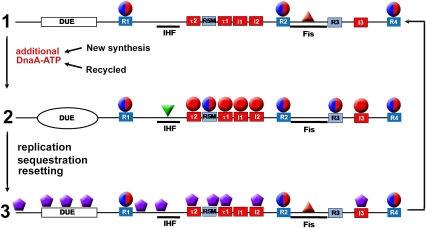Figure 1.
Nucleoprotein complex assembly at oriC during the cell cycle. (Stage 1) DnaA occupies the three higher-affinity R boxes—R1, R2, and R4—throughout the cell cycle, with Fis bound to its cognate site. This complex forms the bacterial version of the ORC. (Stage 2) As additional DnaA-ATP accumulates in the cell, either by new synthesis or by recycling of DnaA-ADP, lower-affinity sites τ1, τ2, I1, I2, I3, with preference for DnaA-ATP, become occupied, as well as nondiscriminatory sites R5M and R3. Fis is displaced, and IHF binds between R1 and R5M. This results in formation of the pre-RC, with localized DNA strand separation in the duplex unwinding region (DUE). (Stage 3) After new replication forks duplicate oriC, the resulting hemimethylated DNA binds SeqA, allowing resetting of the ORC, but preventing reformation of the pre-RC (sequestration). Sequestration lasts for one third of the cell cycle, and the origin returns to the ORC. Red spheres are DnaA-ATP, red-blue spheres are either nucleotide form of DnaA, purple hexagons are SeqA, and red and green triangles are Fis and IHF, respectively.

